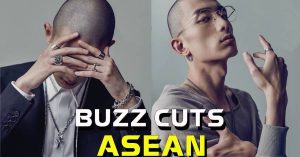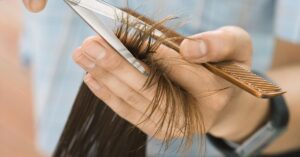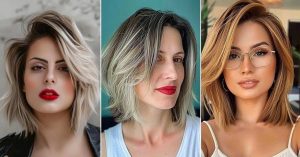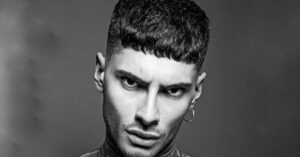Textured Haircuts for Men: Stylish & Trend‑Ready Look

Introduction
It’s simple to understand why men’s textured haircuts have become one of the most popular styles in contemporary grooming. These styles add movement, volume, and personality to hair, making them perfect for men who want a fashionable yet low-maintenance look. Whether your hair is straight, wavy, or curly, texture can transform it from flat and plain to stylish and dynamic. The allure of textured cuts is their adaptability; they look great in business environments, on informal weekends, and everywhere in between.
Another reason textured haircuts for men are trending is that they suit nearly every face shape and hair type. By adding layers and creating natural separation, these styles enhance your hair’s best features while remaining easy to manage. From messy crops to textured quiffs and fringes, there’s a style for everyone. In this guide, we’ll explore different textured haircuts, how to choose the right one for your face shape, tips for styling, and how to maintain your look with ease.
Understanding Hair Texture and Why It Matters
When you hear “texture,” think grain, dimension, and natural movement. The way hair strands fall and reflect light is referred to as its texture. Men’s textured haircuts leverage this by layering or chopping to create visible depth. This matters because it transforms flat, lifeless hair into a dynamic style. Moreover, texture works well on most hair types from wavy to straight, thin to thick.
You actually want a cut that feels alive and moves with you rather than stays rigid. Paying attention to texture ensures that your haircut looks natural, flows well, and remains flexible as your hair grows. In effect, it makes styling easier and gives a polished finish every day.
What Is Hair Texture?
The shape and lay of the hair strand are described by its texture. Straight hair may lie flat, wavy hair has soft bends, and curly hair forms spiral shapes. But texture also includes thickness and the degree of bend or wave in each strand. When barbers talk about texturing, they mean removing bulk, adding edges, or creating irregular lengths so that light hits at different angles.
This process results in hair that appears lived-in and natural. Texture can be added via point cutting, razoring, or using thinning shears. All these methods break up uniform lengths and breathe life into the haircut. Understanding texture means you know how your hair can work with your face, not against it.
How Texture Enhances Hairstyles
Texture amplifies style by adding dimension and lift. Instead of hair sitting flat, textured cuts create peaks and valleys, making hair look thicker. This effect helps fine or thinning hair seem fuller. It also softens sharp hairlines and roughens overly smooth cuts for a more rugged, relaxed look.
Texture lets you style with fingertips rather than brushes or combs, making daily grooming quick and intuitive. It adds versatility too. You can flip strands, tousle them, or push them up for volume all without much product. Ultimately, texture makes a men’s haircut feel alive, modern, and effortlessly cool.
Top Types of Textured Haircuts for Men
Textured haircuts for men come in many variations, each with its own personality. A key advantage of these cuts is their adaptability. No matter your hair type, straight, wavy, or curly, there’s a textured style that can complement it. Short textured crops work great for men who want low maintenance, while medium styles like fringes or shags give a relaxed vibe. A quiff adds volume, making it perfect for special occasions.
Curly or wavy tops pair well with fades to balance structure and movement. To get that lived-in, organic texture, each style employs layering or razor methods. Choosing the right type often comes down to your face shape, lifestyle, and how much time you want to spend styling. The beauty of textured haircuts is that they look intentionally stylish, whether slightly messy or neatly arranged. This balance of structure and freedom makes them one of the most versatile hair trends for men today.
The Messy Crop
The messy crop is one of the most popular textured haircuts for men because it looks effortless yet modern. The top is cut in short, uneven layers that create a slightly disheveled appearance. Sides are usually faded or tapered to keep the look neat. The beauty of the messy crop is that it suits nearly all hair types and requires minimal daily effort. A small amount of matte styling paste can add more separation and definition.
This style works especially well for men with straight or slightly wavy hair because the uneven layers naturally hold shape. The messy crop is perfect for casual settings but can be styled neatly for formal occasions. With its low maintenance and timeless appeal, this textured haircut remains a go-to for men who want a balance of style and simplicity.
The Textured Quiff
For men who need volume and sophistication with a contemporary touch, the textured quiff is perfect. The quiff lifts hair away from the forehead, creating height, while texturing breaks up the smoothness for a more relaxed vibe. This haircut works best on medium-length hair, where layers on top are left long enough to style upward.
Depending on personal desire, the sides might be tapered or faded. What makes the textured quiff different from the classic quiff is the natural separation in the hair. Instead of a polished, combed look, this style appears more casual and easygoing. It’s a great choice for men who want a stylish haircut that can transition from the office to a night out with minimal adjustment.
The Modern Fringe
The modern fringe is a trendy choice among textured haircuts for men. It keeps length in the front, allowing hair to fall slightly over the forehead. Texturing prevents the fringe from appearing heavy by lightening and breaking up the strands. This style pairs well with faded or undercut sides, adding a sharp contrast that frames the face.
The modern fringe is versatile; it can be worn straight, messy, or slightly wavy depending on your natural hair type. Men with straight or fine hair often benefit from this cut because it adds volume at the front while keeping the overall look balanced. It’s also a great option for men with higher foreheads, as the fringe draws attention to the eyes and softens the hairline.
The Wavy or Curly Top with Fade
For men with natural waves or curls, a textured top with a fade is a standout style. The top is left longer to showcase the natural curl pattern, while the sides are faded to create a clean shape. Texture is built into the cut by layering and shaping the curls for definition. This style works particularly well for men who want to embrace their natural hair texture without it looking bulky.
Using curl-enhancing creams or sea salt sprays can help maintain definition and reduce frizz. This cut blends structure and freedom, giving curly or wavy hair a modern edge. The fade on the sides ensures the style remains sharp, making it perfect for men who want texture but still prefer a neat outline.
The Shaggy Layers
Shaggy layers are perfect for men who prefer a relaxed, almost surfer-like appearance. This textured haircut features longer layers that create movement and a natural flow. It works well for men with medium to thick hair, especially if there’s a natural wave. Shaggy layers don’t require precise styling, just a bit of product to add separation or tame flyaways. The uneven, layered look helps reduce bulk while keeping volume in the right places.
It’s a versatile option that works in casual settings but can be refined with a blow-dry for more polished occasions. The shaggy style thrives on texture, making it one of the best examples of how layered cuts can transform a simple haircut into something dynamic and effortlessly stylish.
Choosing the Right Textured Haircut for Your Face Shape
Choosing the right textured haircut for men involves more than just picking a style you like. Face shape plays a major role in how a haircut looks. A textured cut can enhance your strongest features or balance proportions if chosen carefully. For example, men with round faces often benefit from styles with height, like a textured quiff, to create an elongated effect.
Square faces work well with softer textured styles, such as fringes, that balance sharp jawlines. It’s simple to understand why men’s textured haircuts have become one of the most popular styles in contemporary grooming. Heart-shaped faces look great with cuts that add fullness around the temples and jawline to balance the forehead. Understanding your face shape helps you work with your natural structure, ensuring your textured haircut looks natural and flattering.
Oval Face
Men with oval faces have balanced proportions, making this face shape ideal for most textured haircuts. A messy crop, textured quiff, or even shaggy layers can all work without overwhelming the natural symmetry. The goal for oval faces is to maintain balance and avoid styles that make the face appear longer than it is.
Texture helps by adding width and volume where needed. Because the oval face shape is so versatile, you can experiment with different textured looks until you find one that matches your personal style.
Round Face
The allure of textured cuts is their adaptability; they look great in business environments, on informal weekends, and everywhere in between. A textured quiff or messy crop with extra volume on top can help elongate the face. Side fades or tapered cuts reduce the roundness and create sharper lines.
The way hair strands fall and reflect light is referred to as its texture. Texture is key here because it breaks up the smoothness and adds dimension, creating a more structured appearance that flatters the round shape.
Square Face
The shape and lay of the hair strand are described by its texture. To get that lived-in, organic texture, each style employs layering or razor methods. A modern fringe or wavy top helps balance the sharp angles.
Keeping some length on top adds movement, while faded or tapered sides keep the look clean. Texture also helps blend the strong lines of the face with a more relaxed hairstyle, creating a harmonious balance.
Heart‑Shaped Face
Heart-shaped faces have wider foreheads and narrower chins. The goal with textured haircuts for men in this case is to add volume at the sides or near the jawline to balance proportions. Shaggy layers or wavy tops work well.
Avoid styles that create too much height without width, as this can emphasize the forehead. For men who need volume and sophistication with a contemporary touch, the textured quiff is perfect.
How to Ask Your Barber for a Textured Cut
Getting the right textured haircut for men starts with clear communication at the barbershop. Barbers work best when they understand exactly what you want. Using the right terms is important—mention words like “layers,” “point cut,” or “razored texture” to describe the effect you want. Bringing photos is extremely helpful. Your barber can better see the precise texture and length you’re going for if you have a visual reference.
It’s also a good idea to discuss maintenance—some textured cuts require regular trims to keep their shape. Being honest about your hair type and how much time you spend styling will help your barber choose the best version of a textured cut for you. The more specific you are, the better your haircut will match your expectations.
Using the Right Terms at the Barbershop
Barbers often have their own terminology for textured cuts, so knowing a few keywords can help. Ask for “textured layers” if you want movement, or “point cutting” if you want a natural separation. Mention whether you want a “matte finish” or “defined edges.”
These phrases assist prevent misunderstandings and convey the style you want. Your barber may also recommend specific variations based on your hair type, ensuring the texture looks intentional and lasts longer.
Bringing Photos & Showing Texture Style
Pictures make communication much easier. Before your appointment, look for photos of textured haircuts for men that match your hair length, type, and desired style.
Show these to your barber and point out details you like whether it’s the fringe, the fade, or the layering. This ensures that your barber has a clear vision and can replicate the look more accurately.
Styling and Maintenance Tips
Textured haircuts for men are stylish, but they also need the right care to look their best. Clean, slightly damp hair is typically the first step in styling. Using a lightweight styling product like matte clay, cream, or sea salt spray helps define layers without making hair stiff. Blow-drying on a low heat setting can enhance volume and lock in shape.
Regular trims every 4–6 weeks keep the texture fresh and prevent the style from looking overgrown. Maintenance is minimal compared to more structured cuts, but consistency is key. With the right styling habits and products, textured haircuts can look sharp and stylish every day without much effort.
Daily Styling Products for Texture
Choosing the right product makes a big difference. Matte clay is ideal for short, choppy textures because it adds definition without shine. Sea salt spray works well for wavy or curly textured cuts, enhancing the natural pattern.
Styling cream can keep longer textured styles in place while maintaining movement. Always start with a small amount of product and add more if needed—too much can weigh the hair down.
How to Blow‑Dry & Use Paste or Clay
Blow-drying helps bring out the layers in textured cuts. Aim the airflow upward to create lift. For added hold, work a pea-sized amount of paste or clay through your hair once it’s dry. This keeps the texture visible throughout the day. Avoid heavy gels or wet-look products, as they can flatten the layered effect.
Routine Trims to Keep Texture Fresh
Trims every few weeks prevent textured haircuts from losing shape. Overgrown layers can make hair look heavy or messy in a way that’s not intentional. A quick refresh at the barber keeps the style sharp and the texture defined.
DIY Textured Haircut at Home
Cutting a textured haircut for men at home is possible, but it requires patience and the right tools. While professional barbers have the skill to create perfect texture, you can achieve a decent result with practice. Start by understanding the style you want short crop, layered quiff, or messy fringe. Use mirrors to check all angles, as textured cuts require even layering. Remember, less is more when cutting at home.
It’s better to start with small trims and gradually add more texture. A tidy workstation and adequate illumination have a significant impact. Keep in mind that textured haircuts depend on irregular lengths and layered shapes, so precision is less important than creating natural movement. If done carefully, a home haircut can refresh your style between barber visits.
Tools You Need
For a textured haircut at home, invest in sharp scissors, a quality clipper set, sectioning clips, and a fine-tooth comb. If you want to cut bulk without cutting length, a thinning shear is helpful. A handheld mirror helps check the back. Using the right tools ensures a cleaner result and prevents uneven cuts.
Step‑by‑Step Cutting Guide
Begin with clean, dry hair. Section the top and sides. For texture, use scissors or point-cutting methods to produce uneven edges. On the sides, use clippers to fade or taper, depending on your style. Keep checking the shape in mirrors to maintain balance. After you’re happy, smooth off any sharp edges for a more organic appearance.
Safety and Clean‑Up Tips
Work slowly to avoid mistakes or accidental cuts. To catch hair, wrap a cape or cloth across your shoulders. Keep the area well-lit. To keep things clean, vacuum or sweep your hair when you’re done. Proper safety and clean-up make the process smooth and stress-free.
Mistakes to Avoid When Getting Textured Haircuts
Even though textured haircuts for men are versatile, certain mistakes can ruin the style. Over-thinning is a common issue. It can make hair appear flat instead of full. Using too many styling products is another mistake. It can weigh the hair down, making texture invisible. Cutting hair too often or waiting too long between trims can also affect the shape. If you pay a little attention, you can easily avoid these mistakes.
Always communicate with your barber about your desired look and maintenance schedule. For styling at home, start with a small amount of product and build gradually. The goal of a textured haircut is a natural, effortless appearance—avoid anything that makes it look forced.
Over‑Thinning Hair
While removing bulk is essential for texture, over-thinning can make hair look weak. For fine hair types in particular, this is true. A skilled barber knows how much to thin without losing volume. If you’re cutting at home, be cautious with thinning shears.
Using Too Much Product
Styling products should enhance texture, not hide it. Using too much paste, clay, or spray can weigh hair down. Always apply small amounts and adjust as needed to keep the haircut looking natural.
Cutting Too Often or Too Little
Trimming too frequently can remove layers before they settle, while waiting too long can make the style lose shape. A balanced schedule every 4–6 weeks keeps texture fresh without over-maintaining.
Benefits of Textured Haircuts for Men
Textured haircuts for men are popular because they combine style, comfort, and versatility. One major benefit is the natural volume they provide. Textured cuts create movement and fullness without the need for heavy styling. They are also low-maintenance. Unlike sleek hairstyles that require constant touch-ups, textured styles often look better as they grow. Versatility is another key advantage.
Whether you prefer a casual look or something more formal, textured haircuts adapt easily. They work for nearly all face shapes and hair types, making them accessible to almost everyone. In short, a textured haircut is stylish, practical, and suits different lifestyles.
Keeping Texture in Longer Hair
Textured haircuts aren’t just for short hair, medium and long styles can also benefit from texture. The key is strategic layering. Medium to long layers add movement and reduce bulk while maintaining length.
Products like sea salt spray or lightweight oils enhance the natural texture. For men with wavy or curly hair, keeping longer textured layers helps define the wave pattern. Regular trims prevent split ends and keep the shape neat. With the right care, longer textured styles can look fresh and modern without feeling heavy or unkempt.
Medium to Long Layers
Medium to long layers prevent hair from appearing flat or weighed down. They also make styling easier by creating natural separation. This technique works especially well for men who want volume without sacrificing length.
Using Sea Salt Sprays & Light Oils
Sea salt sprays add natural grit, enhancing texture and waves. Light oils can keep hair healthy and reduce frizz. These products help maintain a clean, effortless style without making hair greasy.
Comparison: Textured vs Smooth Hairstyles for Men
Choosing between textured and smooth hairstyles often depends on lifestyle, personality, and maintenance preference. Textured haircuts for men have a relaxed, natural look, while smooth styles appear more polished and structured. Textured styles usually require less daily work and are more forgiving as they grow out.
Smooth hairstyles need precise cuts and more frequent touch-ups to stay sharp. For hair type, textured cuts work well for fine or wavy hair, while smooth styles often suit straight hair. In terms of appearance, texture adds volume and movement, while smooth cuts create a sleek, formal look. Both styles have their place, but textured cuts are often more versatile and easier to maintain.
Appearance
Textured haircuts offer a natural, dynamic look, while smooth styles have a clean, uniform finish. Each creates a different vibe depending on the occasion.
Effort Level
Textured cuts require minimal daily styling, while smooth hairstyles need more precision to maintain their sleek appearance.
Best for Hair Types
Textured styles work well with wavy, curly, or fine hair, while smooth styles are ideal for straight, thick hair that holds shape.
Real Examples & Celebrity Inspirations
Textured haircuts for men have been embraced by countless celebrities, making them a strong trend in modern grooming. Actors, athletes, and musicians often choose textured styles for their versatility and camera-ready appeal. For instance, Chris Hemsworth frequently sports a textured crop or quiff, which enhances his natural volume and relaxed style. Timothée Chalamet is known for its longer, layered texture that works perfectly with his wavy hair.
David Beckham has showcased everything from messy crops to textured fringes, proving how adaptable the style can be. By looking at celebrity examples, men can see how textured haircuts suit different personalities and occasions. Bringing photos of these styles to your barber can help you get a similar look. Whether you prefer a rugged, laid-back cut or a polished, high-fashion style, celebrity inspirations provide endless ideas.
Cost and How Often to Refresh Your Texture Cut
The cost of textured haircuts for men varies depending on the barber’s experience, location, and the complexity of the cut. On average, you can expect to pay between $25 and $70 at a barbershop. High-end salons or celebrity barbers may charge more, especially if they specialize in advanced texturing techniques.
Refreshing a textured cut is just as important as the initial style. To maintain shape and definition, trims every 4–6 weeks are recommended. This keeps layers sharp and prevents the haircut from becoming too heavy or uneven. Over time, sticking to a maintenance schedule ensures your textured style always looks intentional and fresh.
Final Thoughts on Textured Haircuts for Men
Textured haircuts for men are more than just a passing trend. They’ve become a staple in modern men’s grooming. Their biggest advantage lies in their adaptability. Whether you want a professional look, a casual weekend style, or something edgy, a textured cut can deliver. With the right layers, products, and maintenance, textured hair can work for almost any hair type and face shape.
It’s a style that grows gracefully, looks effortless, and requires minimal upkeep. If you’re looking for a haircut that balances style, ease, and individuality, textured haircuts are one of the best options available. The key is to communicate clearly with your barber, choose a style that complements your features, and keep up with simple maintenance.
FAQs
Q1: Are textured haircuts good for thin hair?
Yes, textured haircuts are excellent for thin hair. Layers create the illusion of volume, making hair appear fuller and thicker.
Q2: How do I maintain my textured haircut at home?
Use lightweight products like matte clay or sea salt spray, blow-dry for volume, and trim every 4–6 weeks to keep the shape fresh.
Q3: Do textured haircuts require a lot of styling time?
No, most textured styles are low maintenance. A few minutes with the right product is usually enough to style them daily.
Q4: Can textured haircuts work for curly hair?
Absolutely. Curly hair benefits from texture, as layers help shape the curls and prevent the style from looking bulky.Q5: What’s the difference between a textured and layered haircut?
Layering is a technique to create different lengths, while texturing involves adding movement and separation often using layering, razoring, or thinning.




